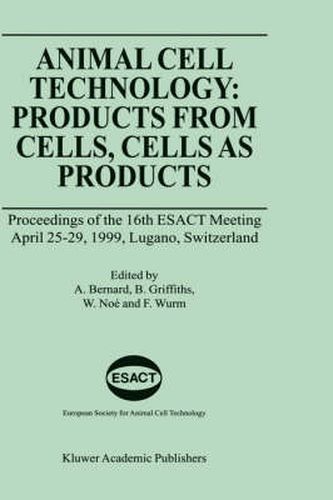Readings Newsletter
Become a Readings Member to make your shopping experience even easier.
Sign in or sign up for free!
You’re not far away from qualifying for FREE standard shipping within Australia
You’ve qualified for FREE standard shipping within Australia
The cart is loading…






This title is printed to order. This book may have been self-published. If so, we cannot guarantee the quality of the content. In the main most books will have gone through the editing process however some may not. We therefore suggest that you be aware of this before ordering this book. If in doubt check either the author or publisher’s details as we are unable to accept any returns unless they are faulty. Please contact us if you have any questions.
Containing, in the form of concise papers of limited length, the proceedings of the 16th ESACT meeting that was held in Lugano, Switzerland, in April 1999, this text is intended to provide a useful resource of the most up-to-date information in animal cell technology, at least until the next meeting in 2001. Classical approaches for the use of animal cells (for example, production of virus vaccines) remain an important technology. However, it appears that major technological advances and major growth are occurring in other areas. Most importantly, protein production on the basis of recombinant DNA molecules transferred into animal cells appears to be an ever-increasing field of interest and innovation. Increasingly animal cells are being used as substrates for the study of gene activation and repression, and also for the more rapid production of small and moderate quantities of interesting proteins. Tissue engineering, somatic gene/cell therapy, organ-replacement technologies, and cell-based bio-sensors all contribute to a considerable widening of interest and research activity, based on animal cell technology.
$9.00 standard shipping within Australia
FREE standard shipping within Australia for orders over $100.00
Express & International shipping calculated at checkout
This title is printed to order. This book may have been self-published. If so, we cannot guarantee the quality of the content. In the main most books will have gone through the editing process however some may not. We therefore suggest that you be aware of this before ordering this book. If in doubt check either the author or publisher’s details as we are unable to accept any returns unless they are faulty. Please contact us if you have any questions.
Containing, in the form of concise papers of limited length, the proceedings of the 16th ESACT meeting that was held in Lugano, Switzerland, in April 1999, this text is intended to provide a useful resource of the most up-to-date information in animal cell technology, at least until the next meeting in 2001. Classical approaches for the use of animal cells (for example, production of virus vaccines) remain an important technology. However, it appears that major technological advances and major growth are occurring in other areas. Most importantly, protein production on the basis of recombinant DNA molecules transferred into animal cells appears to be an ever-increasing field of interest and innovation. Increasingly animal cells are being used as substrates for the study of gene activation and repression, and also for the more rapid production of small and moderate quantities of interesting proteins. Tissue engineering, somatic gene/cell therapy, organ-replacement technologies, and cell-based bio-sensors all contribute to a considerable widening of interest and research activity, based on animal cell technology.